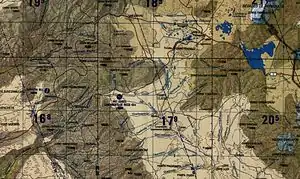Canal Lauca
The Canal Lauca is an artificial channel to divert the waters of the Lauca River westward through a canal and tunnel into the Azapa Valley for purposes of irrigation in the valley and hydroelectric-power generation. Its construction began 1948 and water diversion began 14 years later from a dam located about 16 miles southwest of Lago Cotacotani Lake.

The canal lies in the commune of Putre in the Arica y Parinacota Region of Chile. It is 33 kilometres (21 mi) long and has a capacity of 1.9 cubic metres per second (67 cu ft/s).[1] It transfers water from the Lauca River into the Rio San Jose for irrigation[2] and hydropower purposes; the endpoint of the canal includes the Chapiquiña power plant which produces 56 gigawatt-hours per year (6.4 MW).[3] Typically about 0.8 cubic metres per second (28 cu ft/s) are transferred;[3] a plan to transfer additional water from Lake Chungara was blocked after litigation by an environmentalist group.[4]
The canal was put into service in 1962 and is owned by the government of Chile.[1] As a consequence of the construction of the canal, the surface of irrigated land in the Azapa valley increased. This also led to increased immigration from Bolivia into Chile.[5] The construction of the canal led to protests by Bolivians[6] and appears to have primarily favoured large agribusiness.[7]
The Lauca River originates at the Laguna Cotacotani, which in turn receives seepage water from Lake Chungara.[8] It first flows due westward before turning south and later back east into Bolivia.[9] After draining a watershed of 2,350 square kilometres (910 sq mi), the river ends in the Salar de Coipasa of Bolivia.[8]
References
- PROCIVIL INGENIERIA LTDA (2009). "CATASTRO DE OBRAS DE RIEGO Y ELABORACIÓN DEL PLAN DE INVERSIONES AL AÑO 2018 ZONA NORTE - REGIONES DE ARICA Y PARINACOTA A METROPOLITANA" (PDF) (in Spanish). Santiago: Ministry of Agriculture (Chile). p. 126. Archived from the original (PDF) on 3 March 2018. Retrieved 2 March 2018.
- Cade Idepe 2004, p. 20.
- Cade Idepe 2004, p. 21.
- Hearne, Robert R.; Easter, K. William (1995). Water Allocation and Water Markets: An Analysis of Gains-from-trade in Chile. World Bank Publications. p. 54. ISBN 9780821335284.
- "Bolivia selecciona 50 familias en valles en de Arica para repatriarlas" (in Spanish). Instituto Nacional de Reforma Agraria. 14 December 2009. Retrieved 2 March 2018.
- Justwan, Florian; Fisher, Sarah K. (2017). "Generalized Social Trust and International Dispute Settlement". International Interactions. 43 (5): 726. doi:10.1080/03050629.2017.1257490.
- Meza Aliaga, Mónica Soledad; Pereira Acuña, Karem Angélica; Jofré Cañipa, Juan Gabriel; Meza Aliaga, Mónica Soledad; Pereira Acuña, Karem Angélica; Jofré Cañipa, Juan Gabriel (September 2020). "Saberes y estrategias de adaptación a la disponibilidad hídrica en las yungas secas del norte de Chile". Revista de geografía Norte Grande (76): 255–277. doi:10.4067/S0718-34022020000200255. ISSN 0718-3402.
- Cade Idepe 2004, p. 1.
- Cade Idepe 2004, p. 2.
Source
- Cade Idepe (December 2004). "DIAGNOSTICO Y CLASIFICACION DE LOS CURSOS Y CUERPOS DE AGUA SEGUN OBJETIVOS DE CALIDAD: CUENCA RIO LAUCA" (PDF) (in Spanish). Ministry of Public Works (Chile). Retrieved 2 March 2018.CS1 maint: ref=harv (link)